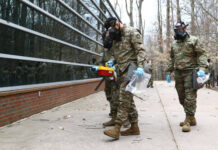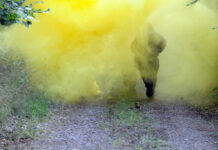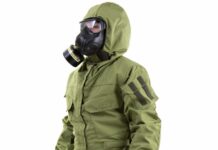There is a commonplace belief that somehow the military has, if not a monopoly, a large share of the knowledge on how to respond to Chemical, Biological, Radiological and Nuclear (CBRN) threats. This belief, in turn, is rooted in Cold War thinking when CBRN threats were something on the battlefield and not something that had much to do with incidents in peacetime. Further, this dates from a time when many countries had larger, more robust militaries which took the Cold War CBRN threat seriously and had force structure in their militaries devoted to such threats, which is often now greatly reduced.
Military CBRN scenarios, often quite old, postulate situations on the modern battlefield which bear little resemblance to the kinds of situations that civil emergency responders might face. The actual case history of CBRN incidents in the civil sector include events like the Tokyo subway Sarin attacks, Fukushima and Chernobyl-type nuclear power accidents, attempted assassinations involving chemical agents (such the Salisbury incident) and the 2001 Anthrax attacks in the USA. The parameters of these scenarios vary considerably from battlefield scenarios.
In current reality, dealing with chemical terrorism and dealing with accidents involving commercial hazardous materials is really not that different. The difference between a chlorine tank leaking due to a transportation accident and a chlorine tank leaking due to terrorism is not actually all that different. Most of the response actions are identical other than the intent of the perpetrator and, perhaps, some of the post-incident forensic investigation. Calling in the military to deal with something that, if it had happened by accident, the fire brigade would have dealt with, might be an incorrect course of action. Conversely, there are purely civil scenarios where military help may be needed. For example, the chaos and damage caused by a large hazardous materials accident or a serious nuclear power plant incident might necessitate military support. Navigating this subject requires serious calculations and consideration.
Operational Considerations
Military support to CBRN incidents can be structured several ways. Use of military capabilities may be pre-planned, as in the case of major public events. An example of this might be military CBRN support to a major sporting event, coordinated months or even years ahead of time. Most of the time, however, a CBRN incident does not give planners the luxury of happening at a time and place when additional planning and assets have been allocated. Generally, civil responders such as ambulance services, police, and fire will be the front-line first responders. The key questions in such situation are who makes the decision that military support is need and, if needed, what support is actually needed.
Decisions to request support from the military can be pre-planned, with standing procedures and pre-existing authorisations for certain types of incidents. Such processes are long-standing in the area of ordnance disposal but are far rarer to date in CBRN incidents. This leaves two situations for consideration. Often there is a bottom-up approach, where local authorities request support from higher levels of government, which then gets passed on to the military. Alternatively, there is a top-down approach where central government, seeing the size and scope of the problem, sends in military support without a request from the local responders. In countries structured along a federal system, such as Switzerland or Germany, multiple layers of governance may need to be involved. Both scenarios require appropriate administrative and legal frameworks. The existence and quality of such frameworks varies greatly within Europe. Furthermore, as CBRN situations may not be well understood by political leaders, they may need training or have to rely upon professional advice.
Best Practices
Regardless of how decisions get made to deploy the military to support an emergency response to CBRN incidents, experience from natural disasters and non-CBRN terrorism is relevant. A best practice has emerged from non-CBRN incidents is that the civil authorities should frame their requests for military support in terms of specific capabilities and missions, not in terms of personnel or units. “We need to be able to decontaminate 40 ambulances and fire trucks – can you support that?” and “We need to move 500 people evacuated from their homes, temporarily house them, and field them” are reasonable examples of requests of capability. “Send us six helicopters” or “we want an infantry battalion” are less useful requests. In addition, local and regional authorities may need help understanding just exactly what military capabilities do exist or are available. There are likely to be instances where local authorities assume certain military capabilities exist when, in fact, they do not. For example, some plans for the London 2012 Olympics referenced some British Army capabilities that had ceased to exist between the planning and execution of the Olympics. There might be situations in Europe where military force not available for domestic emergencies because it is deployed overseas on a NATO, EU, or UN mission. A convoy of trucks deployed in Mali cannot easily support a CBRN incident in Europe.
Another important consideration in military support in CBRN incidents is the use of reservists. Much of the military expertise in relevant CBRN mission areas in many countries is actually in the form of reserve units and reservist soldiers as the peacetime requirement for CBRN defence is often judged to be fairly light. One problem often not noticed is that many such reservists actually work in the emergency services in their normal jobs. Mobilising them to deal with an emergency can be at best a false economy and at worst, a detriment to emergency response. The extent to which this factor is relevant varies from country to country and may even vary regionally within countries. Policies to rely principally upon reservists from areas unaffected by the particular incident are used in some countries, and this emerges as another best practice.
A final consideration is incident command systems. CBRN incidents may require multidisciplinary responses from across the spectrum of emergency services and the medical sector. Because multiple organisations will have to work together, incident command systems have long provided useful frameworks for cooperation. It is absolutely vital that military units and, most importantly, the leaders of these units, understand how they fit into incident command systems. A best practice is to make sure existing incident command systems (often already in use in the fire and rescue sector) can be adapted to CBRN incidents and that appropriate military leaders and their planning staffs can become familiar with them. Although not expressly aimed necessarily at the military angle, several relevant EU projects (FIRE-IN being a current example as a relevant Horizon 2020 project) have been active in this space.
Forms of Military Support
Military support to civil authorities can take many forms, both specialised to CBRN response and in broader support roles. Decontamination is often mentioned as a useful military capability. Generally, firefighting services are tasked with decontamination in civil emergencies involving CBRN agents or hazardous materials. Military CBRN decontamination units have training and equipment to greatly augment the ability of first responders to conduct vital personnel and equipment decontamination. However, there are far fewer military decontamination platoons and companies in active service across Europe since the end of the Cold War. Even before the formal end of the Cold War, CBRN units started drawing down and/or converting to reservist-only organisations. Some countries in Europe have very little capacity in this area or are reliant on reservists that might take days to mobilise.
Military CBRN units often can bring detection and identification capabilities, particularly for chemical warfare agents or radiological hazards. Military units can bring additional instrumentation to an incident. Further, specialty CBRN reconnaissance units and military mobile laboratories are specifically intended to identify hazards, conduct sampling, and provide relevant information. Many European militaries have such labs. Finally, there are a number of specialised defence CBRN laboratories in Europe. Spiez (Switzerland), FOI (Sweden), FFI (Norway), WIChiR (Poland) and WIS (Germany) are all examples of such laboratories in Europe. These laboratories can provide useful analytical support to CBRN incidents. Of equal importance, these laboratories are a useful repository of subject matter expertise. The individual and institutional knowledge represented by these labs is an immense asset.
Controlling Access
One aspect of response to CBRN incidents is the need to control access and maintain secure cordons and perimeters. An act of CBRN terrorism could produce large crime scenes that need securing. Large areas that are contaminated may large numbers of personnel to secure perimeters, exceeding police capacity. Military personnel, who are generally trained and equipped to use CBRN protective clothing and respiratory protection, can easily augment or replace police for this duty. Specialists are not needed; infantry soldiers could easily stand post to maintain a perimeter.
CBRN incidents may require response and recovery measures that incur a significant logistical footprint. Feeding, housing, and transporting personnel and supplies is part of crisis response and recovery. Military logistical capabilities may be very important after an incident. They are not CBRN-specific, but trucks, tents, and helicopters may be at least as important as other military contributions in many situations.
Case Study: Civil Support Teams
It is useful to look at two case studies of military support for CBRN incidents. The first is organisational. The US example of National Guard Civil Support Teams (CSTs) is numerically the most significant example of military support to civil CBRN response. (In full disclosure, this author spent five years in such a unit, from 1998-2003). In the 1990s it was decided National Guard, which had a long history of civil support in emergencies, could prepare for and respond to CBRN terrorism in the USA.
The CSTs are 22-person units specifically designed for assisting at the scene of a CBRN incident and have extensive training in both military and civil sector emergency response. As National Guard assets, they administratively belong to their various states, but are federally funded. The core of the CBRN capability is a survey team to conduct sampling and identification. Each team also has a mobile analytical laboratory and a specialty communications suite. Despite the fact that the various National Guards are almost entirely reservists, CSTs are the exception. They are on active service, thus available more quickly. The CSTs now have decades of practice supporting major public events.
Case Study: Salisbury
In March 2018, highly toxic nerve agent was used in an attempted assassination of Sergei Skripal, a former Russian military intelligence officer. The incident (discussed in issue 7/2018 of this magazine) became both an international diplomatic incident and a lengthy CBRN incident. The Salisbury incident quickly exceeded the capability and capacity of the local emergency responders and additional support was needed, from other government agencies as well as the military. Approximately 190 British Army and the Royal Air Force personnel, supported the response. These military personnel were critical to sample collection and decontamination operations, including safe removal of vehicles with trace levels of contamination. Of equal importance was the support provided by the Defence Science and Technology Laboratory at Porton Down. This lab represents the core of the UK military’s subject matter expertise on chemical and biological threats. Their analysis identified the agent and their staff analysed thousands of samples of evidence from Salisbury.
CBRN incidents, such as terrorism or hazardous materials incidents, may require capabilities that exceed those of local responders. The military represents a pool of such capabilities. But not every military capability is an easy fit for civilian requirements. Planning and liaison before an incident are very important to ensure that military support to civil authorities can be optimised.













